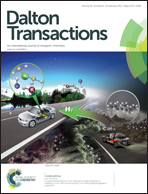Isomeric thiophene-fused benzocarborane molecules—different lithium doping effect on the nonlinear optical property†
Abstract
Recently, two isomeric thiophene-fused benzocarborane derivatives Tb1 and Tb2 with different locations of sulfur atoms, labeled as 1, 4 and 6, 9 of the thiophene were synthesized by Morisaki (Chem.–Eur. J., 2012, 18, 11251–11257) and Barrere (Macromolecules, 2009, 42, 2981–2987), respectively. In the present work, natural bond orbital (NBO) analysis shows that after doping one lithium atom into the isomeric structures Tb1 and Tb2, the electrons transfer to different regions in Tb1 and Tb2. For Tb1-Li, the transferred electrons mainly locate at S1, C2, C3, and S4, but for Tb2-Li, the transferred electrons mainly locate at C2, C3, C7, and C8. Significantly, the charge distribution is a crucial factor influencing the static first hyperpolarizabilities for Tb1-Li and Tb2-Li. Furthermore, the βtot value of Tb1-Li is 6222 au, which is about 160 times larger than that of Tb1 (39 au). However, the βtot value of Tb2-Li (498 au) is only about 5 times larger than that of the corresponding Tb2 (91 au). It is our expectation that this work could provide useful information for the development of nonlinear optical materials based on carboranes.


 Please wait while we load your content...
Please wait while we load your content...